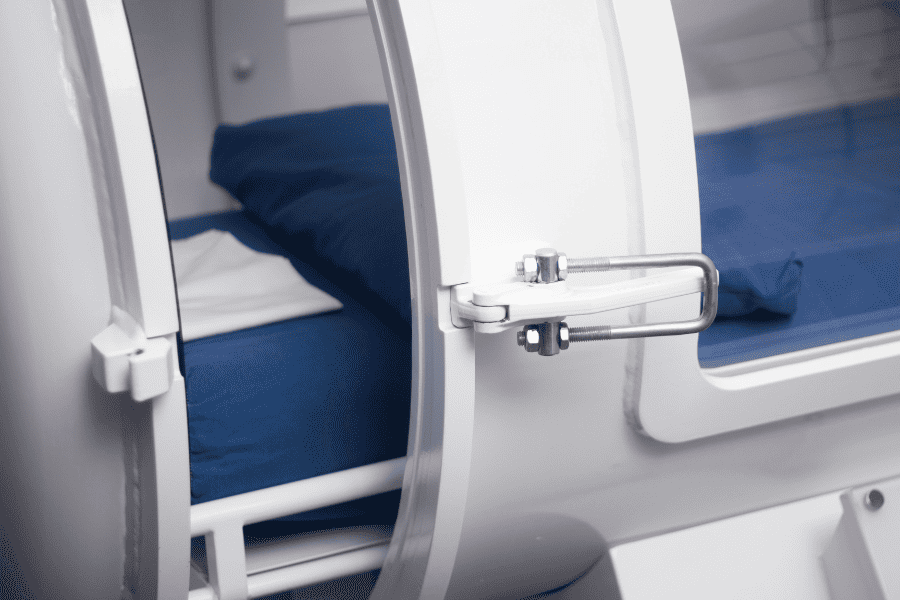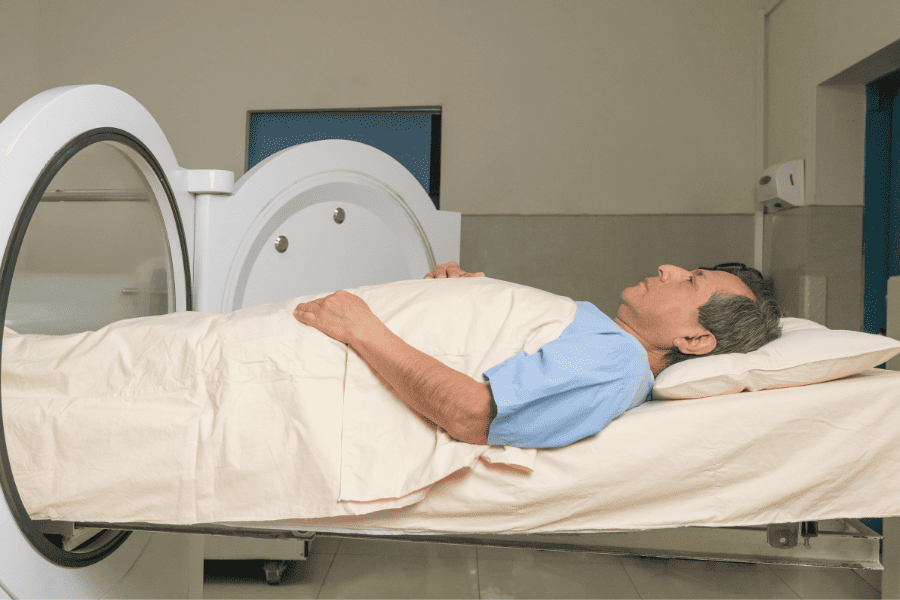- How does hyperbaric oxygen therapy work?
- When is hyperbaric oxygen therapy used?
- What to expect during hyperbaric oxygen therapy?
- Are there risks for undergoing hyperbaric oxygen therapy?
Hyperbaric oxygen therapy uses oxygen to heal wounds. In fact, this treatment has been used more than 50 years for a variety of disorders, including complex wound treatment. Some studies show hyperbaric oxygen therapy is effective in healing chronic wounds as much as 77.5% of the time.
Martin Schnell, M.D., founder of Rapha Wound Care, has a particular interest in hyperbaric oxygen to help heal wounds. Dr. Schnell calls this therapy very effective, particularly with wounds that would otherwise end up as chronic non-healing conditions.
So, how does hyperbaric oxygen help heal a wound and what type of patient would benefit from this therapeutic approach?
How Does Hyperbaric Oxygen Therapy Work?
 Hyperbaric oxygen therapy, or HBOT, is an effective way to treat carbon monoxide poisoning, dangerous infections, gangrene, and other conditions where the patient’s tissues are oxygen-starved. Dr. Schnell says hyperbaric therapy, remarkably, creates a new blood supply.
Hyperbaric oxygen therapy, or HBOT, is an effective way to treat carbon monoxide poisoning, dangerous infections, gangrene, and other conditions where the patient’s tissues are oxygen-starved. Dr. Schnell says hyperbaric therapy, remarkably, creates a new blood supply.
Like the name implies, the treatment uses “super charged” levels of oxygen to flood the body and promote healing. You may have seen this treatment used on underwater divers who become ill or on firefighters suffering from carbon monoxide poisoning. The treatment reverses dangerous conditions that damage the body’s blood vessels. The blood vessels in turn release fluid that causes tissue swelling. This swelling deprives the body’s cells of oxygen and then tissues start to die.
Hyperbaric oxygen therapy floods these tissues with oxygen, allowing the body’s own immune system to kick in and heal itself. The patient receives this treatment in a sealed, pressurized container. Typically, there are a series of these treatments and they can be expensive. Check to see if Medicare or your private insurance carrier will cover these procedures.
Hyperbaric oxygen therapy has been shown to increase formation of new connective tissue and skin cells. It can also block the progress of certain harmful bacteria and strengthen the body’s immune system. The therapy can also prevent a reperfusion injury, which is tissue damage that occurs when blocked blood flow returns to tissue.
However, there is controversy around these treatments. The U.S. Food & Drug Administration (FDA) has only approved hyperbaric oxygen therapy for a few types of treatments. This typically means that insurance carriers only cover these approved treatments.
A growing number of healthcare clinics are offering these treatments as a form of alternative therapy to treat everything from asthma, depression, and HIV, to Alzheimer’s disease, and spinal cord injuries. There are even at-home hyperbaric oxygen chambers. It’s important to only receive approved hyperbaric oxygen treatments to avoid any side effects.
When is Hyperbaric Oxygen Treatment Used?
 There are currently more than a dozen indications where hyperbaric medicine is approved for use. Dr. Schnell says many of them are not related to wounds however.
There are currently more than a dozen indications where hyperbaric medicine is approved for use. Dr. Schnell says many of them are not related to wounds however.
Hyperbaric oxygen therapy can be used to treat:
- Actinomycosis, or a chronic infection commonly of the face or neck
- Air or gas embolism (the bends)
- Carbon monoxide poisoning
- Cyanide poisoning
- Decompression sickness
- Inadequate arterial blood flow
The primary wound-related problems that would call for hyperbaric treatment include:
- Arterial or deeper wounds where oxygen can’t reach inside the body
- Compromised skin grafts or flaps
- Crush injuries where tissue has been compressed
- Gas gangrene, where gas collects in tissues
- Necrotizing wounds (flesh-eating disease)
- Infection of the bones (osteomyelitis) which are difficult to heal because of poor blood supply
- Radiation injuries that happen from radiation therapy
Dr. Schnell says hyperbaric oxygen therapy starts “a process called angiogenesis, which actually causes the formation of new capillaries and new vessels in that area of tissue that’s been destroyed.” Despite the treatment’s effectiveness for some disorders, it is also widely used for “off-label” treatments that can mislead patients and be less effective than other options.
“I would caution people who are told they need it; it’s a very complicated procedure,” he says. “Hyperbaric oxygen therapy is often a four-hour long daily process, often for weeks at a time.”
What to Expect During Hyperbaric Oxygen Therapy?
 Hyperbaric oxygen therapy is usually an outpatient procedure over a series of days, but the number of treatments depends on your illness or injury.
Hyperbaric oxygen therapy is usually an outpatient procedure over a series of days, but the number of treatments depends on your illness or injury.
Typically, the patient will receive the treatments in a sealed chamber which can be a small metal tube or a larger room for more than one person at a time. The ambient pressure inside the room or chamber is three times higher than normal air pressure.
Dr. Schnell says, “Hyperbaric oxygen delivers 100% oxygen – under pressure, which effectively gives you the equivalent of 250%, or two and a half times more oxygen.”
He points out the delivery of oxygen in this manner forces oxygen into the damaged areas, which helps deeper tissues, such as arterial wounds, begin to heal.
Are There Risks for Undergoing Hyperbaric Oxygen Therapy?
While hyperbaric oxygen therapy is generally safe, there are risks associated with undergoing these treatments. They include:
- Lowered blood sugar in insulin-dependent diabetics
- Lung collapse due to pressure changes in the hyperbaric chamber
- Middle ear injuries due to the increased pressure
- Oxygen toxicity causing seizures
More mild side effects from hyperbaric oxygen therapy could include feeling lightheaded, fatigued, or having a headache.
To benefit from hyperbaric oxygen therapy, you will need more than one treatment, generally. It’s a time-consuming process. For example, while carbon monoxide poisoning may clear up in three visits, non healing wounds may take 40 visits. Given that each session is two or three hours long, the time you need to devote to these treatments is substantial.
Dr. Schnell says, “I’m happy to do second opinions and you’ll get it straight from me. If you need it, I’ll refer you but if you don’t, I’ll spare you.”
Today there are all kinds of treatments available to treat chronic wounds. Rapha Wound Care specializes in providing care to patients struggling with everything from diabetic foot ulcers and burns to open surgical wounds or other types of traumatic wounds.
If you’ve been referred to treatment with hyperbaric oxygen therapy it can be confusing to know if the approach is the right one, so a second opinion with a specialist may be warranted.

